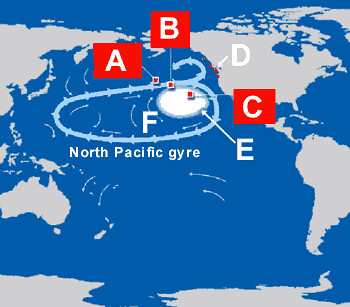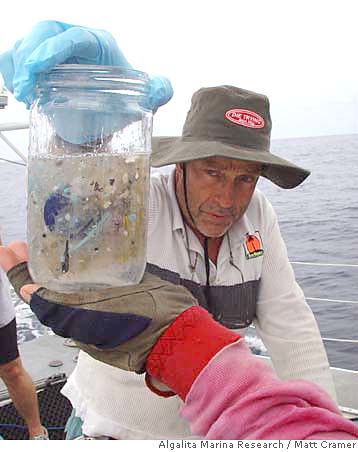
Plastic is EVERYWHERE these days. With 3-5 percent of plastic actually being recycled, and the continuous push to make more and plastic goods, the world is becoming engulfed in this translucent substance. The real problem with plastic is that for something so abundant, and widely consumed, it is actually extremely hazardous to the human race, and might join Oreo’s on the list of why Timmy’s got a weight problem.

The North Pacific Gyre is a swirling vortex of ocean currents comprising most of the northern Pacific Ocean. It is located between the equator and 50º N latitude and occupies an area of approximately ten million square miles (34 million km². In the middle of this ocean lies a sign of human consumption so striking that it is all but surprising this hasn’t become a bigger issue then…. oh lets say what ever those crazy young celeb’s got up to this week
.

What has been appropriately dubbed the "Great Pacific Garbage Patch" is an odd stretch of ocean, a place most boats purposely avoided. The ocean’s top predators: tuna, sharks, and other large fish that require livelier waters, flush with prey all avoid this ocean dead spot. The gyre is more like a desert, deep, clockwise-swirling vortex of air and water caused by a mountain of high-pressure air that lingered above it. Here one will find islands of floatasm and a plankton to plastic ratio of 1:6.

Plastic photo degrades, disintegrating in the ocean into smaller and smaller pieces. The pieces become so small they resemble zoo plankton and eventually are consumed by jellyfish, thus entering the food chain. Yes, im sure it is probably a few links up the food chain before you find that plastic in your Mcfish, so restless night syndrome hasn’t really kicked in yet, but rest assured this is not to be taken lightly.

Jellyfish aren’t the only animals to consume this plastic mess, sea birds are being found with stomach full of plastic items ranging from tampons applicators, lighters, cups, and other small pieces of plastic resembling bait fish. One Dutch researcher found an albatross with 1603 pieces of plastic inside its skeletal frame.

So why is this plastic bad for you? Why should one worry about the dangers of something that is used so widely in our everyday life. Our water comes packaged in it, meals are kept in, our dogs play with it, and it’s essentially societies go to semi-synthetic polymerization product. The problem is plastic is a petroleum-based mix of monomers that become polymers, to which additional chemicals are added for suppleness, in flammability, and other qualities. When it comes to these substances, even the syllables are frightening. Example, if you’re thinking that perfluorooctanoic acid (PFOA) isn’t something you want to add to garnish your next plate with, then you would be right. Recently, the Science Advisory Board of the Environmental Protection Agency (EPA) upped its classification of PFOA to a likely carcinogen. Yet it’s a common ingredient in packaging that needs to be oil- and heat-resistant. So while there may be no PFOA in the popcorn itself, if PFOA is used to treat the bag, enough of it can leach into the popcorn oil when your butter deluxe meets your superheated microwave oven that a single serving spikes the amount of the chemical in your blood.
In food containers and plastic bottles, phthalates are found with another compound called bisphenol(BPA), scientists have discovering can wreak havoc in the body. The world produces 6 billion pounds of BPA each year, and it shows as BPA has been found in nearly every human who has been tested in the United States. We’re eating these plasticizing additives, drinking them, breathing them, and absorbing them through our skin every single day.

Most alarming, these chemicals may disrupt the endocrine system—the delicately balanced set of hormones and glands that affect virtually every organ and cell—by mimicking the female hormone oestrogen. MORE surprising then this is Dr. Vom Saal research which has indicated that prenatal exposure to low levels of BPA increased the rates postnatal growth in mice and rats. In layman terms...it made the babies fat. With the higher rates of postnatal growth, the rodent’s natural rate of insulin rose drastically then plunged violently, the definition of diabetes. The research only becomes more frightening when you realize that the diabetes rate has risen a 735 percent since 1935.

Except for the small amount that’s been incinerated—and it’s a very small amount—every bit of plastic ever made still exists. Even when plastic is broken down to a single molecule, it remains too tough for biodegradation. Truth is, no one knows how long it will take for plastic to biodegrade. The stuff was only invented 144 years ago. Science dictates its natural disappearance will take a few more centuries.

So Seattle just jumped on the bandwagon of cities banning plastic water bottles, in an attempt to keep the Starbucks home base on par with its pristine west coast image. The city spent 58 k on bottled water last year (not including the carbon footprint). So I would like to take this time to give away my first "shout-out" to Mayor Greg Nickels for his green steps forward for the Emerald city. Congratulations Seattle, not only is he a looker, he's a smart man.
